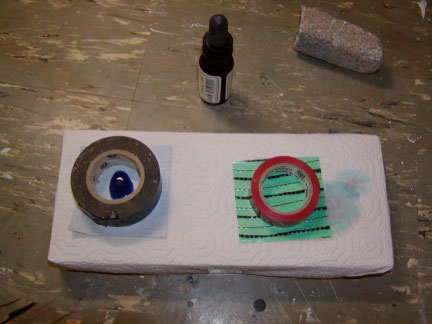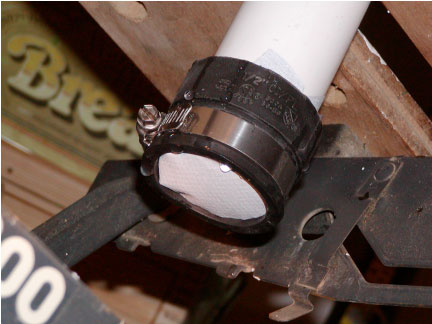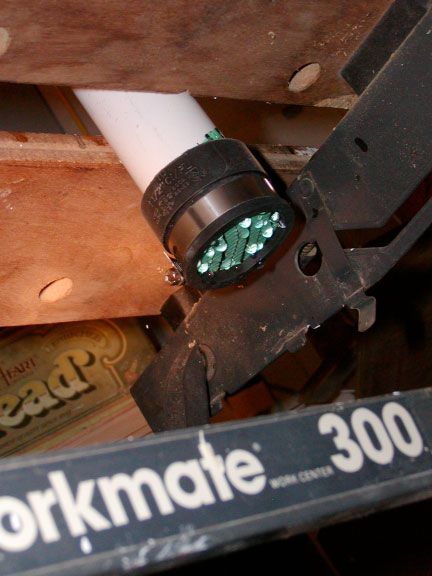
How do you know if your housewrap really works?
In the good old days, we weatherlapped 3-ft. courses of building paper underneath our wall claddings, and that seemed to work just fine. But then along came all sorts of snazzy “gift wrappings” (a.k.a. housewraps) in handy, 9-ft. rolls. Some claimed to be both air barriers as well as water-resistive barriers; others claimed to be vapor permeable. Along the way, it got pretty confusing about just exactly what the housewrap’s job is in our walls. (For a practical and detailed perspective on housewraps, see “Making Sense of Housewrap”.)
Benchtop version of the hydrohead test with SBPO. There is a full 22-in. column of water in the pipe, and the SBPO is not leaking (those drops of water you see is water getting around the fitting and clamp, not coming through the housewrap).
Benchtop version of the hydrohead test with gross crosswoven. The water started dripping through the gross crosswoven housewrap as soon as it was poured into the pipe.
While we may well want our housewraps to do more than one thing for our walls, the International Residential Code (IRC) 2006 building code tells us what the primary job is:
The housewrap has to resist water at least as well as traditional building paper. But the phrase “other approved water-resistive barrier” (WRB) is where everything heads south for builders and designers selecting housewrap. There are dozens of tests or test conditions that housewrap manufacturers invoke to claim approval.
The American Society for Testing and Materials (ASTM) is hard at work straightening out this mess (ASTM Task Group E06.55.07), but headway has been mighty slow. The current draft of the housewrap standard recognizes three tests for resistance to water (manufacturers must choose one):
- ASTM D779 – the “boat” test: Originally designed for just regular old paper, this test involves making a little folded-up boat from the test material, placing it in water, and timing how long it takes an indicator dye to show up. In the building industry, this is mostly used for building papers, but the perforated housewrap (e.g., Owens Corning PinkWrap) and gross crosswoven (e.g., Pactiv housewraps, except its UltraWrap) guys like this low- or no-pressure test.
- AATCC 1 127 – the hydrostatic pressure or “hydrohead” test: This test is from the plastic baggy guys and involves clamping the test material to the bottom of plastic pipe and then filling the pipe with water to a height of 20 in. or so, then waiting for the test material to leak three drops. This is the test that most of the spun-bonded polyolefin (SBPO) manufacturers like. It’s a high-pressure test— the full 22 in. is roughly equivalent to a hurricane-force wind of more than 200 mph.
- CCMC 2 water-ponding resistance test: In this test, 1 in. of water is placed in a bowl-shaped sample of the wrap. The water cannot pass through the bowl for at least two hours. This pressure in test is somewhere between the other two.
The great thing about all three tests is that a work bench version of each is really easy to do. Paul Fisette, head of the Building Materials and Wood Technology Department at the University of Massachusetts in Amherst, was the first to adjust the ASTM D779 “boat test” to mimic real building conditions (called the “modified boat test”). Just stick a paper towel as a blotter between the housewrap and sheathing and wood siding, and press these components together as they would be in a typical wall. Then take the “sandwich” apart and see if the paper-towel blotter got wet.
See the pictures on the right for some benchtop non-ASTM versions of the modified boat and hydrohead tests. The non-perforated SBPO (translation: Tyvek or Typar) passed both tests, and the gross crosswoven housewrap (translation: Pactiv Raindrop) failed both. Building paper passed the modified boat test but is not really suited to the hydrohead test.
Bottom line? I think you need to benchtop test your own housewraps until ASTM gives us a standard that separates the wheat from the chaff. These benchtop tests are easy to do, and you can see for yourself which WRB materials hold water, literally. In my experience and benchtop testing, perforated and gross crosswoven housewraps simply don’t pass muster.
More on what else we might want housewraps to do in a subsequent blog.
………………….
1 This is the American Association of Textile Chemists and Colorists (AATCC).
2 This is the Canadian Construction Materials Center (CCMC).
Weekly Newsletter
Get building science and energy efficiency advice, plus special offers, in your inbox.

















7 Comments
Hands on Testing
Peter, I like your concept of hands on testing... I think we should all be building mock-ups of our building systems so that we can test new ideas before we bury them in a wall.
Concerning Weather Barriers (leaning toward felt myself)don't you think it would be more realistic to test the weather barrier in a more vertical position? Perhaps arrange some leaky cladding in front of the WRB and then spray the cladding with a hose?
A wood shingle roof with gaps can shed water well but probably would not make a good water container if you inverted it and applied head pressure.
Case for space between WRB and back of cladding
I can't claim to have done any of my own testing but it seems to me if you take minimize the pressure differences between one side of the WRB and the other then the 'leakiness' of the material isn't as much of a problem. Can a case be made that a well installed but low quality housewrap will resist water leaks as well as a premium housewrap when the cladding is installed over a rainscreen vent space? If this works, then we can essentially subsidize the cost of rainscreen materials (furring strips, plastic matrix, plastic battens, dimple mat....) by purchasing 'cheap' housewrap as opposed to more costly versions.
case for space
Hi Mike -
Might work, but I worry about contact areas, particularly with furring strips, but even with spacer mesh at penetrations where contact is inevitable. But you are right; some housewraps that "don't work" are a bit better than others. Paul Fisette argues that building paper is still the way to go, and I think in terms of cost, I would agree with him if you have a vented, drained space between the cladding and the WRB. But I also think that depending on how long the WRB will be up unsupported or uncovered plays into this. The new ASTM standard has tear resistance woven into it, so that may help separate the wheat from the chaff on another front--tearing and fasteners.
Real weaknesses in evaluating WRBs
These are comments from Tom Butt, a leading architect and member of the ASTM group working on the new ASTM standard for mechanically attached WRBs:
"One of the real weaknesses in evaluating WRBs, in addition to those you mentioned, is that the typical WRB, after application, is full of holes where cladding, lath, etc is fastened. There is substantial evidence that fastener holes play a role in a lot of leaks.
All of the WRB tests are conducted on uncompromised materials, as far as fasteners go.
Most experts agree that the only way to fully evaluate a WRB is to mock up an entire wall assembly and test it under some variation of ASTM E 1105. But the sheer volume of potential assemblies makes that impossible as an industry standard."
Thanks Tom.
Home Improvement
It's a shame that the state of housewraps in general is such that you can't trust manufacturers to provide reliable information and find yourself in the position of needing to invent integrity tests for items that should simply work as promised. Does that make me irrational to expect that? This is professional building material is it not? Why should we not expect professional quality?
Old Guy Likes Tarpaper
When you pull fasteners out of tarpaper they have a coating of tar on them. This indicates there may be an self-sealing quality that plastic wrap can't match. The ability to absorb, store, and release moisture to the opposite side could be one of the most beneficial properties of tarpaper.
Intelligent installation is required for all materials. I double wrap the bottom course and all corners. That's 4 layers when installing double D! The upper corners at windows and doors also gets lapped properly with no leak slits needed.
35 years and no callbacks.
raindrop
Thought I would share results of using Raindrop. I used this product on a new home in 2002. It's built on a mountain and exposed to wind regularly in the northeast US. It was sided with white cedar sidewall shingles that were pre-dipped in Cabot's solid stain. I am doing more work on the house now (2013) and the siding (and trim) has held up remarkably well. There were maybe 40 shingles that showed some moderate cupping. The house was re-stained about 4 years ago.
Log in or create an account to post a comment.
Sign up Log in